What Type of Bees Drill Holes in Wood?

Bees are known for their important role as pollinators, but did you know that some bees also have a fascinating ability to drill holes in wood? These bees are known as wood-boring or carpenter bees, and they can cause significant damage to structures such as wooden decks, fences, and even houses.
Carpenter bees belong to the Xylocopa genus and are found worldwide. These bees are larger in size compared to other bee species and are often mistaken for bumblebees. However, one key difference is that carpenter bees have a shiny and hairless abdomen, while bumblebees have a hairy abdomen. Male carpenter bees are more aggressive and can be seen flying near the wood, guarding their territory.
Wood-boring bees drill holes in wood to create nests for their offspring. The female carpenter bee uses her strong jaws to excavate a hole in a wooden surface, typically about half an inch in diameter. Once inside, she will create a series of tunnels, each divided into separate cells. The female then provisions each cell with a mixture of pollen and nectar, on which she lays a single egg. When the egg hatches, the larva feeds on this stored food until it pupates and transforms into an adult bee.
It’s important to note that carpenter bees do not eat the wood they drill into. Instead, they use the wood as a place to lay their eggs and create a safe environment for their offspring. However, the drilling can weaken the wooden structures over time, leading to potential structural damage. It is advisable to take preventive measures to protect wooden surfaces from carpenter bees, such as painting or sealing the wood with an appropriate protective coating.
Identification of Wood Drilling Bees
Wood drilling bees are a type of solitary bee that nests in wood by drilling holes. They are commonly known as carpenter bees. These bees can be found in various regions around the world and are known for their unique drilling behavior.
Appearance:
- Wood drilling bees are large in size, typically ranging from ½ to 1 inch in length.
- They have a robust and shiny black body, sometimes accompanied by yellow or white markings on their head, thorax, or abdomen.
- Their wings are translucent and tend to have a bluish or purplish tint.
Behavior:
- Wood drilling bees are solitary insects, meaning they do not form colonies or live in hives like honeybees.
- They are excellent pollinators and play a crucial role in the pollination of plants.
- The females have the ability to sting, but they are generally docile and rarely display aggressive behavior.
- Wood drilling bees are known for their drilling behavior, where they create perfectly round holes in wood to build their nests.
Nesting:
- Wood drilling bees prefer to nest in soft or decaying wood, such as old tree trunks, logs, or wooden structures.
- The female bee uses her strong mandibles to excavate a tunnel into the wood, creating a cylindrical hole that can be several inches deep.
- Inside the tunnel, the female constructs individual chambers for each egg, which she provisions with a mixture of pollen and nectar as food for the developing larvae.
- Once the chambers are complete, the female lays her eggs and seals them with a partition made of wood pulp.
Importance:
- Wood drilling bees are important pollinators for many plants, including trees, shrubs, and flowers.
- They help to ensure the reproduction and survival of various plant species.
- Although they may create holes in wood structures, their impact is generally minimal and can be managed through preventive measures such as painting or sealing wooden surfaces.
Summary:
Wood drilling bees, also known as carpenter bees, are solitary insects that nest in wood by drilling perfectly round holes. They are large in size and have a shiny black body. Wood drilling bees are important pollinators and play a critical role in the ecosystem. Although they can cause damage to wooden structures, their impact is generally manageable.
Carpenter Bees
Carpenter bees are a type of bee that drills holes in wood. They are part of the Xylocopa genus, which includes over 500 species worldwide. These bees are known for their ability to create perfectly circular holes in wood, often causing damage to structures like wooden houses, decks, and furniture.
Appearance:
- Carpenter bees are large and robust, usually measuring around 1 inch in length.
- They have a shiny black or metallic blue-black coloration on their bodies.
- Their wings are transparent and slightly tinted.
Behavior:
- Male carpenter bees are usually more aggressive and can often be seen guarding their territory.
- Female carpenter bees are solitary and have the ability to sting, although they are not typically aggressive towards humans unless provoked.
- These bees are excellent pollinators and are known to be important for the reproduction of certain plants.
Nesting Habits:
- Carpenter bees excavate tunnels in wood to create their nests.
- These tunnels can reach a length of 6 to 10 inches, with chambers where the female lays her eggs.
- The holes created by carpenter bees are typically perfectly round and about half an inch in diameter.
Wood Damage:
- The drilling activities of carpenter bees can weaken the structural integrity of wood over time, leading to potential damage and costly repairs.
- They often target softwoods like pine, cedar, and redwood, but can also infest hardwoods.
- It is important to address carpenter bee infestations promptly to prevent further damage.
Prevention and Control:
- One way to deter carpenter bees from drilling holes in wood is by painting or varnishing the surfaces, as bees are less likely to excavate treated wood.
- Filling existing holes with wood putty or caulk can prevent further nesting.
- Installing screens or nets over vulnerable areas can also help keep carpenter bees away.
- Professional pest control services may be necessary for severe infestations.
In conclusion, carpenter bees are a type of bee that drills holes in wood to create nests. Their drilling activities can cause structural damage to wood over time. However, with proper preventative measures and timely intervention, it is possible to control and minimize the impact of carpenter bee infestations.
Bumblebees
Bumblebees are large, fuzzy bees that are known for their buzzing sound and gentle nature. They belong to the genus Bombus and are found in various parts of the world, including North America, Europe, Asia, and Africa. Bumblebees play a crucial role in pollinating flowers and crops, making them important for the overall biodiversity and food production.
There are over 250 species of bumblebees, each with its distinct characteristics and traits. Some common species include the garden bumblebee (Bombus hortorum), the buff-tailed bumblebee (Bombus terrestris), and the red-tailed bumblebee (Bombus lapidarius). Bumblebees are recognized by their round, furry bodies with black and yellow stripes.

Life Cycle and Behavior
Bumblebees have a complex life cycle, consisting of a queen, workers, and males. The queen starts a new colony in the spring by finding a suitable nesting place, such as an abandoned mouse hole or under a tuft of grass. She builds a small wax nest and lays her eggs, which hatch into small larvae. The queen then feeds the larvae with pollen and nectar until they pupate and emerge as adult worker bees.
The worker bees are responsible for foraging and collecting food, expanding the nest, and caring for the larvae. They are non-reproductive females and do not lay eggs. As the colony grows, new generations of workers are produced, and eventually, males and future queens are produced for mating.
One unique behavior of bumblebees is their ability to perform buzz pollination. They can vibrate their flight muscles at a specific frequency, which causes flowers to release more pollen. This technique is especially effective for certain plant species, such as tomatoes, blueberries, and eggplants.
Importance in Pollination
Bumblebees are important pollinators for a wide variety of plants and crops. They have several adaptations that make them efficient pollinators, such as their large body size, long proboscis, and ability to tolerate cooler temperatures. Bumblebees are also capable of flying in adverse weather conditions, including light rain and high winds.
They visit flowers in search of nectar and pollen, transferring pollen from the male parts of the flower (anther) to the female parts (stigma), allowing for fertilization and the production of seeds. Bumblebees are known to specialize in particular types of flowers, forming mutualistic relationships where both the bees and plants benefit.

Conservation Efforts
Unfortunately, many bumblebee species are facing decline due to habitat loss, pesticide use, climate change, and diseases. The decline of bumblebees can have significant impacts on ecosystems and agriculture, as they play a crucial role in pollinating wildflowers and commercial crops.
Conservation efforts are being made to protect and restore bumblebee populations. These include creating habitat corridors, planting native flowers, reducing pesticide use, and raising awareness about the importance of bumblebees and their conservation.
Conclusion
Bumblebees are fascinating creatures that contribute to the pollination of plants and play a vital role in maintaining biodiversity. Their behavior, unique adaptations, and important ecological functions make them a species worth protecting and appreciating.
Other Wood Boring Bees
In addition to the common carpenter bees, there are several other species of bees that have a similar behavior of drilling holes in wood. These bees are not as well-known as carpenter bees, but they can still cause damage to wooden structures.
Small Carpenter Bees
Small carpenter bees, also known as little carpenter bees or dwarf carpenter bees, are a group of bees that belong to the genus Ceratina. These bees are much smaller than common carpenter bees, usually measuring only ⅜ to ½ inch in length. They are solitary bees, meaning that they do not live in colonies, and they often nest in preexisting holes in wood.
Small carpenter bees are commonly found in North America and can be identified by their slender bodies and metallic blue or green coloration. While they do not cause as much damage as larger wood-boring bees, they can still weaken wooden structures by tunneling into them.
Mason Bees
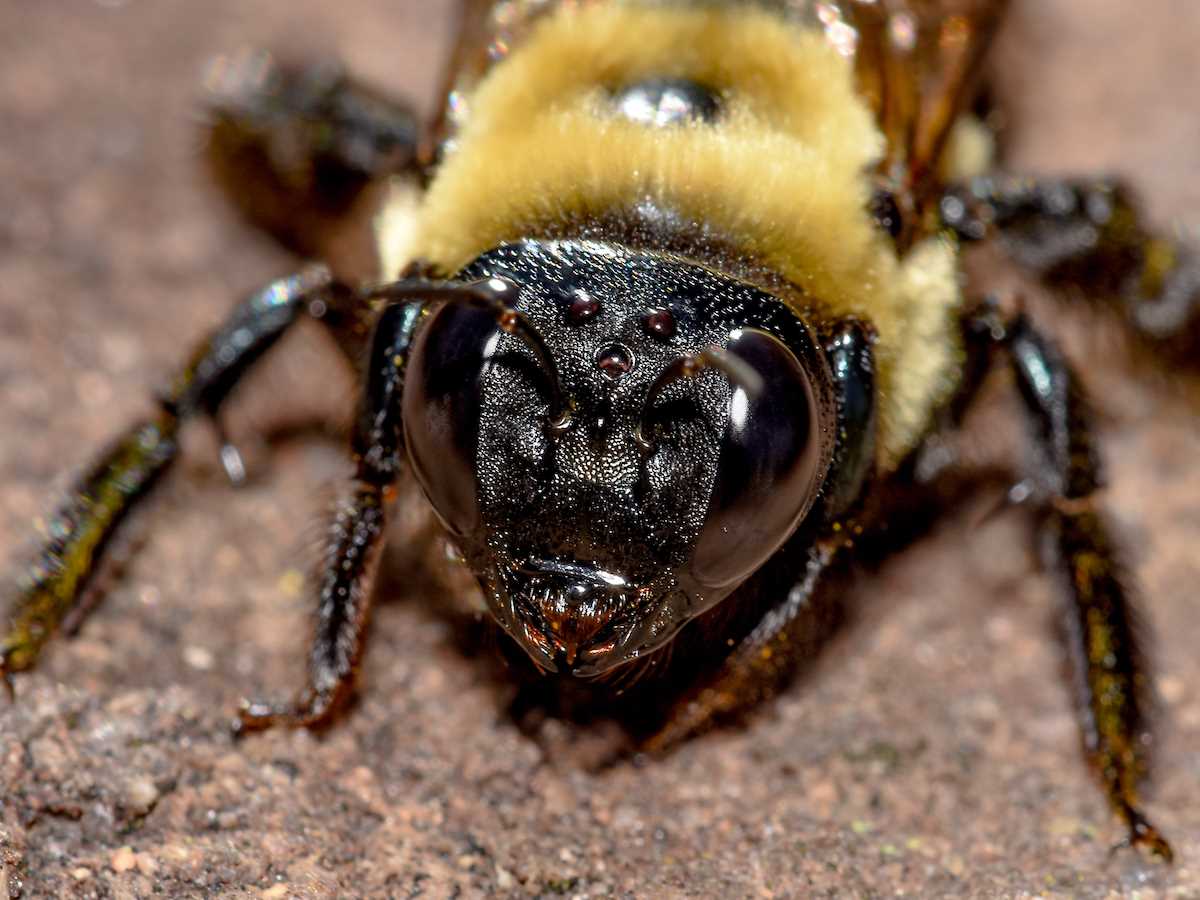
Mason bees, also known as masonry bees or mortar bees, are a group of bees that belong to the genus Osmia. These bees are small to medium-sized and are known for their solitary behavior and ability to create nests in various materials, including wood.
Mason bees are not as destructive as carpenter bees, as they primarily use preexisting holes in wood or other nesting structures. However, their nesting activity can still cause damage to wooden structures over time.
Leafcutter Bees
Leafcutter bees are a group of bees that belong to the genus Megachile. These bees are named for their unique behavior of cutting circular sections of leaves to construct their nests.
While leafcutter bees primarily nest in soft plant materials, such as dried leaves, they can occasionally use preexisting holes in wood as nesting sites. Like other wood-boring bees, their nesting activity can cause damage to wooden structures.
Bark Bees
Bark bees are a group of bees that belong to the genus Xylocopa. Unlike carpenter bees, which primarily tunnel into bare wood, bark bees prefer to nest in the bark of trees.
While bark bees do not directly drill holes in wood, they can still cause damage to wooden structures by chewing through the outer layers of bark and exposing the underlying wood. Once the wood is exposed, other wood-boring bees may take advantage of the openings created by bark bees.
| Bee Species | Size | Nesting Behavior | Damage to Wood |
|---|---|---|---|
| Common Carpenter Bee | ½ to 1 inch | Tunnels into bare wood | Significant damage |
| Small Carpenter Bee | ⅜ to ½ inch | Nests in preexisting holes | Moderate damage |
| Mason Bee | Small to medium-sized | Uses preexisting holes | Moderate damage |
| Leafcutter Bee | Variable sizes | Primarily nests in plant material | Moderate damage |
| Bark Bee | Variable sizes | Nests in tree bark | Indirect damage |
Behavior of Wood Drilling Bees
Wood drilling bees, also known as carpenter bees, are a species of bee that drill holes into wood for shelter and reproduction. These bees can be found in various regions around the world and are often misunderstood as destructive pests. However, they play an important ecological role and have fascinating behaviors.
Here are some key behaviors of wood drilling bees:
1. Hole Construction
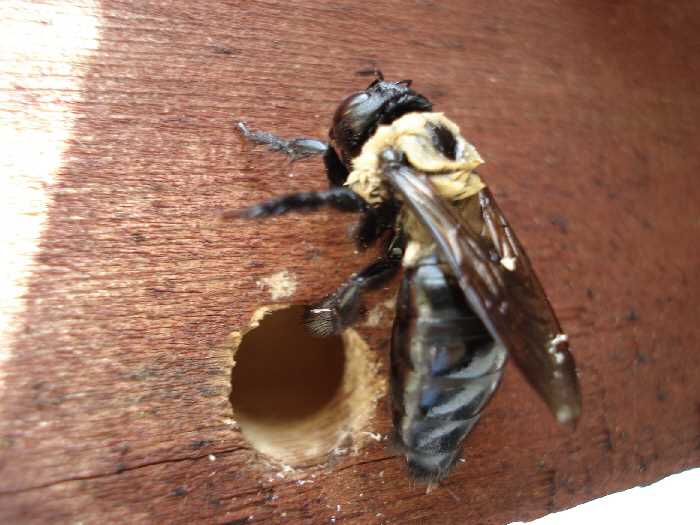
Wood drilling bees excavate nesting holes in various types of wood, including trees, logs, and wooden structures. The female bees use their strong mandibles to bore into the wood, creating perfectly round entrances that are near-perfectly circular in shape. The holes can range in size from a few millimeters to several centimeters in diameter.
2. Tunneling
Once the entrance hole is created, the female wood drilling bee tunnels further into the wood. The tunnels are typically straight or slightly curved and can extend several inches deep. The bees use their mandibles to remove wood debris and create a smooth tunnel surface. These tunnels serve as chambers for the bees to lay eggs and rear their brood.
3. Colony Structure
Wood drilling bees are solitary insects, meaning each female bee constructs and maintains her own nest. However, these bees may construct their nests in close proximity to other individuals, giving the appearance of a colony. Despite this proximity, wood drilling bees do not display the same social behavior as honey bees and bumblebees.
4. Pollination
Wood drilling bees play an essential role in pollination. While they primarily drill holes in wood, they also visit flowers to collect pollen and nectar for their young. As they move from flower to flower, they transfer pollen, allowing for cross-pollination and the fertilization of plants.
5. Mating and Reproduction
Mating behavior in wood drilling bees involves the male bees chasing and mating with the receptive females. After mating, the female will collect pollen and nectar to provision the nest before laying eggs. Each nest chamber is provisioned with food supplies and a single egg is laid before the chamber is sealed.
In conclusion, wood drilling bees exhibit fascinating behaviors related to nest construction, tunneling, colony structure, pollination, and reproduction. It is important to understand their ecological significance and coexist with these creatures, as they are vital for the health and balance of ecosystems.
Nesting Habits
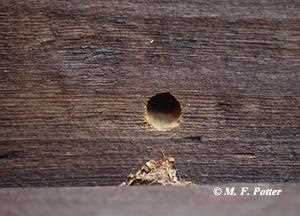
1. Carpenter Bees
Carpenter bees, specifically the genus Xylocopa, are known for drilling holes in wood to create their nests. Female carpenter bees will chew round entrances into various wooden structures, including siding, eaves, decks, and even wooden furniture. These holes are typically about half an inch in diameter.
Once the entrance hole is created, the female carpenter bee will excavate a tunnel that can extend several inches into the wood. This tunnel serves as a gallery for her offspring, where she will deposit eggs on pollen balls she has gathered. Each egg is then sealed with a wall of wood pulp. The larvae will feed on the pollen until they pupate and eventually emerge as adult bees.
2. Horntail Wasps
Horntail wasps, also known as wood wasps or sawflies, are another type of insect that drills holes in wood for nesting. These wasps belong to the family Siricidae and are characterized by their long, slender bodies and pointed “stinger,” which is actually an ovipositor used for laying eggs.
Female horntails use their ovipositors to drill holes into dead or dying trees, particularly conifers. The holes created by horntails are typically larger than those made by carpenter bees and can measure up to an inch or more in diameter. Once the hole is drilled, the female will deposit her eggs into the wood. The larvae that hatch from these eggs will bore into the wood, feeding on the tree’s sap and cellulose.
3. Bumblebees
While not typically known for drilling holes in wood, bumblebees may occasionally use existing holes or natural cavities in wood to build their nests. Bumblebees are social bees that form large colonies, and the queen will seek out a suitable nest site in the spring.
If a suitable cavity or hole is found in wood, the bumblebee queen may take advantage of it, especially if it provides protection from the elements and predators. However, bumblebees are more commonly found nesting in underground burrows, old rodent nests, or thick grass.
4. Mason Bees
Mason bees, also known as masonry bees or cavity-nesting bees, are solitary bees that often use existing holes in wood or natural cavities to construct their nests. These holes can be found in dead trees, hollow plant stems, or even abandoned bee nests.
Female mason bees collect pollen and nectar, and then deposit these provisions in the nest before laying an egg. They then seal off the cell with mud or other materials, creating individual chambers for each offspring. The larvae will feed on the stored food until they pupate and eventually emerge as adult bees.
5. Other Wood-Nesting Bees
There are many other species of bees that may also nest in wood, either by creating their own holes or by utilizing existing ones. Examples include leafcutter bees, sweat bees, and certain types of small carpenter bees.
These bees may exhibit various nesting behaviors, but they commonly utilize holes in wood as a place to construct their nests and rear their offspring. These holes can be found in a variety of wooden structures, such as dead trees, fence posts, and even outdoor furniture.
Foraging Activities
Bees undertake various foraging activities to gather resources such as nectar, pollen, and water. These activities are essential for the survival and reproduction of the colony. Let’s take a closer look at some of the foraging activities bees engage in:
Nectar Collection
Bees primarily collect nectar as a source of energy for themselves and the colony. They visit flowers and use their long tongues, called proboscis, to suck up the nectar from the flowers. Nectar is stored in a special organ called the honey stomach, where it is transported back to the hive.
Pollen Collection
Pollen collection is crucial for the survival of the colony, as it provides the necessary proteins and nutrients. Bees collect pollen by visiting flowers and using their hairy legs and bodies to brush off the pollen grains. The collected pollen is then packed into specialized sacs called pollen baskets, located on their hind legs, and transported back to the hive.
Water Collection
Bees require water for various purposes, including hydration, cooling the hive, and diluting honey. They collect water from sources such as ponds, streams, or even condensation on leaves. Bees use their mouths to collect water and store it in their honey stomach before bringing it back to the hive.
Orienting and Navigation
Bees have remarkable navigational skills and use various strategies to locate food sources and find their way back to the hive. They rely on the position of the sun, landmarks, and even the Earth’s magnetic field to orient themselves. The ability to communicate and share information about foraging sites is crucial for the success of the colony.
Dancing
One fascinating behavior of bees is the waggle dance. Forager bees perform this unique dance on the honeycomb to communicate the location of a profitable food source. The dance involves a series of figures-of-eight movements and buzzing sounds, indicating the direction and distance of the food source in relation to the sun.
Foraging Patterns
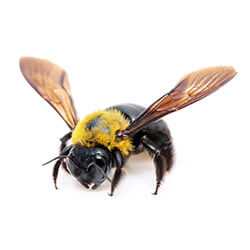
Bees exhibit different foraging patterns depending on environmental factors such as food availability and distance. Some bees may focus on a single food source, while others may explore multiple sources. They may also employ different foraging strategies to optimize their resource gathering, such as selecting the flowers with the richest nectar.
Interactions with Other Species
While foraging, bees interact with various species, such as other bees, butterflies, and birds. These interactions can include competition for resources, such as nectar or pollen, or mutualistic relationships, where bees and other species benefit from each other.
Foraging Efficiency and Adaptations
Bees have evolved numerous adaptations to enhance their foraging efficiency. These can include specialized mouthparts for accessing nectar, long tongues for reaching deep flowers, and hairy bodies for pollen collection. Additionally, some bees, such as carpenter bees, have adaptations for drilling holes in wood to create nests.
In conclusion, bees engage in a variety of foraging activities, including nectar collection, pollen collection, water collection, navigation, dancing, and interactions with other species. These behaviors are crucial for the survival and success of the colony, as they ensure the availability of essential resources and contribute to the pollination of plants.
Potential Risks of Wood Drilling Bees

Wood drilling bees can cause several potential risks, both to wooden structures and to humans. Understanding these risks is essential for effective management and prevention strategies.
Property Damage
Wood drilling bees can cause significant damage to wooden structures, such as decks, fences, and wooden furniture. These bees bore into the wood to create their nests, resulting in holes and tunnels that weaken the structure. Over time, this can lead to structural instability and the need for costly repairs or replacements.
Expanding Infestations
If left unchecked, wood drilling bees can lead to expanding infestations. Female drilling bees can lay multiple eggs in different nests within the same structure, increasing the population over time. This can exacerbate the damage and increase the risk of structural collapse.
Negative Aesthetic Impact
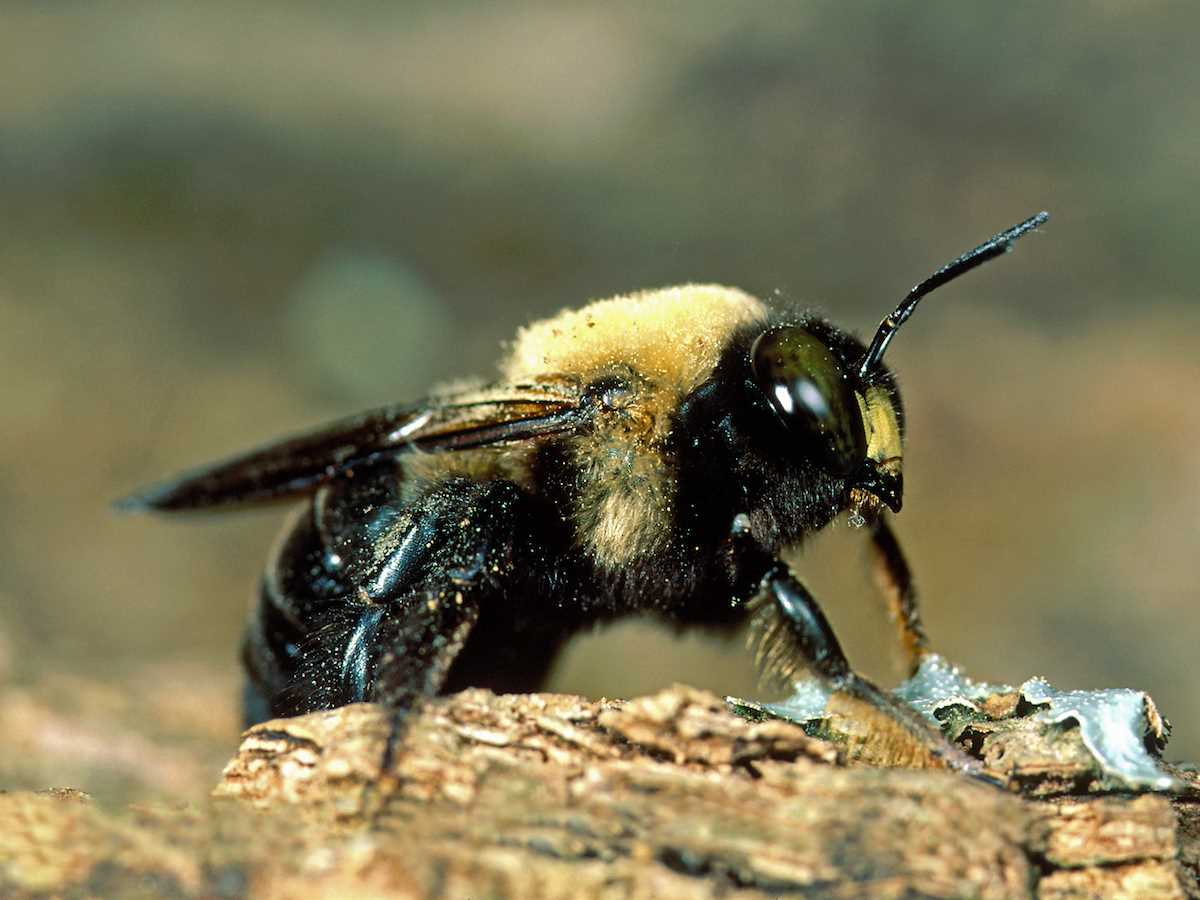
The presence of wood drilling bees can also have a negative aesthetic impact on wooden structures. The visible holes and tunnels created by these bees can be unsightly and diminish the overall appearance of the wood. This can be particularly problematic for outdoor wooden structures where visual appeal is important, such as decks or outdoor furniture.
Allergic Reactions
Wood drilling bees, like other stinging insects, have the potential to cause allergic reactions in humans. Some individuals may be highly sensitive to bee stings and can experience severe allergic reactions, including anaphylaxis. It is important to exercise caution around wood drilling bees, especially if you know you have a bee sting allergy.
Secondary Infestations
Once wood drilling bees create their nesting holes, other insects and pests may also take advantage of these openings. Secondary infestations by pests such as termites, carpenter ants, or wood-boring beetles can further damage the wood and compound the overall risks.
Environmental Impact
Although wood drilling bees play a role in pollination and ecosystem dynamics, their activities can have negative consequences on the environment. By destructively drilling into wooden structures, wood drilling bees contribute to the degradation of natural habitats and can impact the balance of ecosystems in certain areas.
Prevention and Management
To mitigate the potential risks associated with wood drilling bees, it is essential to implement proper prevention and management strategies. These may include regular inspection and maintenance of wooden structures, sealing off potential entry points, applying appropriate insecticides or repellents, and seeking professional help if needed.
In conclusion, wood drilling bees pose several potential risks to wooden structures and humans. Understanding these risks and taking appropriate preventive measures is crucial for minimizing the damage caused by these bees and ensuring the safety and longevity of wooden structures.
Structural Damage
Wood-boring bees can cause significant structural damage to wooden structures. As these bees create their nests by drilling holes into wood, the damage they cause can weaken the integrity of the wood, leading to potential structural failures.
The size and number of holes created by wood-boring bees can vary depending on the species. Some bees create small holes, while others can create large tunnels several inches in length. Over time, these tunnels can weaken the wood, making it more vulnerable to collapse or damage from external factors like strong winds or heavy rain.
In addition to the physical damage caused by drilling holes, wood-boring bees often attract other wood-destroying organisms, such as ants or fungi. These organisms can further deteriorate the wood, exacerbating the structural damage caused by the bees.
Furthermore, the presence of wood-boring bees can also lead to secondary damage. As the bees excavate the wood, they generate sawdust and wood fragments, which can accumulate in and around the affected area. This sawdust accumulation can create a potential fire hazard, as it is highly flammable.
To prevent and address the structural damage caused by wood-boring bees, it is essential to identify and treat infestations promptly. This may involve filling the holes created by the bees with appropriate materials and applying insecticides to deter further activity. Consulting with a pest control professional is often recommended to ensure effective and safe treatment.
Allergic Reactions
Allergic reactions to bee stings can range from mild to severe and can even be life-threatening. When a person is stung by a bee, their immune system may overreact to the venom, causing an allergic reaction. These reactions can vary from person to person and can become more severe with each subsequent sting.
Symptoms of Allergic Reactions
The symptoms of an allergic reaction to a bee sting can include:
- Skin redness and itching around the sting site
- Swelling of the face, throat, or tongue
- Difficulty breathing or swallowing
- Nausea or vomiting
- Dizziness or fainting
- Rapid heartbeat or palpitations
- Abdominal pain or cramping
In severe cases, an allergic reaction can lead to anaphylaxis, a potentially life-threatening condition that requires immediate medical attention. Anaphylaxis can cause a sudden drop in blood pressure, difficulty breathing, and loss of consciousness.
Treatment for Allergic Reactions
If someone experiences an allergic reaction to a bee sting, it is important to seek medical help immediately. In the case of anaphylaxis, an emergency epinephrine injection may be needed to stop the reaction and save the person’s life.
For less severe reactions, over-the-counter antihistamines may help to relieve symptoms such as itching and swelling. Applying a cold compress to the sting site can also provide some relief.
People who have experienced allergic reactions to bee stings may be advised to carry an epinephrine auto-injector (such as an EpiPen) with them at all times, in case of future stings. It is important for them to avoid contact with bees and to take precautions such as wearing long sleeves and pants when outside.
Prevention of Allergic Reactions
Preventing allergic reactions to bee stings involves avoiding bee stings in the first place. Some steps that can be taken to reduce the risk of being stung by a bee include:
- Avoiding brightly colored or floral-patterned clothing, as these can attract bees
- Avoiding sweet-smelling perfumes, lotions, and hair products, as these can also attract bees
- Keeping food and drinks covered outdoors, as bees are attracted to sweet foods and beverages
- Being cautious around flowering plants and beehives
- Keeping windows and doors closed to prevent bees from entering the home
By taking these precautions and being aware of the symptoms of an allergic reaction, individuals can reduce their risk of experiencing severe reactions to bee stings.
FAQ:
Which type of bees drill holes in wood?
The type of bees that drill holes in wood are called carpenter bees.
Why do carpenter bees drill holes in wood?
Carpenter bees drill holes in wood to create nests for their eggs and raise their young.
What kind of damage can carpenter bees cause by drilling holes in wood?
Carpenter bees can cause significant damage to wooden structures by drilling holes, which weakens the wood and can lead to structural issues.
How can I prevent carpenter bees from drilling holes in wood?
To prevent carpenter bees from drilling holes in wood, you can paint or seal the wood to make it less attractive to them, create alternative nesting sites for them to use, or use insecticides specifically designed to repel carpenter bees.
Video:









